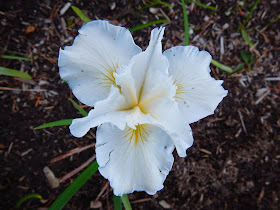Irises are at an inherent disadvantage in a spring-wet climate, because they have upturned flowers like tulips instead of down-turned flowers like many lilies. Hybridizers in dry spring areas have selected for wide, frilly flowers over the past few decades; usually these plants flower in late winter to mid spring. In spring-wet areas, these flowers are hammered by rain, damaged so badly that pollination cannot occur.
 |
| A modern wide-petaled, frilly Pacific Iris flower on a dry day. This is an unnamed seedling, flowering for the first time this year. |
 |
| Another unnamed seedling, a lovely yellow, after a rainstorm. Note the damaged style crests and standards, and melted falls. |
 |
| 'Canyon Snow' when dry, above, and wet, below. This Doug' selection holds up well in rain with sturdy upright stems and durable flowers. |
Older hybrids have narrower petals and less frilling, and often do surprisingly well in heavy rain. Go back about 20 years, to find these sturdy forms. 'Mission Santa Cruz' and 'Cape Ferrelo', to name two, also do well in intense rain.
 |
| 'Harry's Rootbeer' holds up in rain. This hybrid is a 'Mission Santa Cruz' progeny, bred for southern California, which also does well in the Pacific Northwest. |
 |
| Iris tenax from Lewis County, Washington, does well in rain, as do many Pacifica species. |


Which types/varieties would do well in the Northern NJ area? And where might corms be purchased?
ReplyDeleteNew Jersey is a bit outside the comfort zone for Pacifca Iris, due to humid hot summers. To try them, plan on a very well drained soil, and covers to provide summer protection from rain to keep the roots and plants somewhat drier. They also need to be protected from winter cold. Snow cover is great, but cold without snow cover will kill them.
DeletePacific Irises do not produce corms, they have fine rhizomes, and should be planted in spring or fall when roots are growing.
A recent article in Pacific Horticulture, Winter 2014, includes growing tips and sources.
http://www.pacifichorticulture.org/issues/winter-2014/
Sturdy Pacifica Iris include Canyon Snow, Mission Santa Cruz, and Pacific Rim, to name a few. Check the article for sources (you may have to join on line to read the full content).
I will have an article in the Rock Garden Quarterly later this year, on growing Pacificas outside their native range, which may give you many good tips.
I hate when it rains when the iris are starting to bloom, especially for Japanese Iris. Your blooms are still very beautiful!
ReplyDeletecheck out my recent post on my Japanese iris blooming,
Michael
http://michaelswoodcraft.wordpress.com/2014/06/06/japanese-iris-in-bloom/
I tried Japanese iris for several years, and found that the rain was too hard on the flowers. Also, slugs loved the flowers! Between rain and slugs, I rarely could enjoy their flowers, so out they came. If you can grow them well, I envy your growing conditions. If I had large covers, and ducks to keep the slugs down, or less rain in spring, they might be OK in my garden.
ReplyDelete